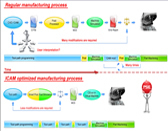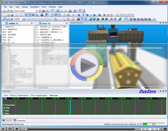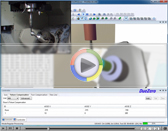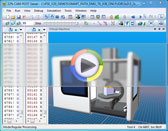Introduction
Past and Present
For many years it was considered mandatory to perform validation testing of CNC programs rigth on the machine tool, relying on the ability to assess and prompt response to the experienced machine operators, able to fix errors in programming.
Today the modern means of simulation-emulation can dramatically reduce these times, considered to be active in the production, moving from the real world to the virtual one good part of the first test carried out directly in the machine tool at the first start of the program (test tape).
Simulation and Emulation
Different Technologies for the design and production
With Emulation Virtual Machine Tool it is intended display kinematic movements based directly on the working program, commonly called Part Program or ISO file. The emulation allows a secure checking of the program of the machine and a rapid reworking of the same in case is modified, or created directly in the processing area, and is particularly suitable to be applied at the end of the production process. Our proposal is based on the emulation applications ICAM Control Emulator + Virtual Machine.
With Simulation Virtual Machine Tool we mean display kinematic movements based on the APT file directly input, developed during the post-processing. Means to simulate the movements of the machine tool based on the decisions taken by the post processor immediately before the time of the creation of the program block machine. It 'important not to confuse this feature with a simple emulation of the APT because this is not the same thing.
Virtual simulation is suitable to be used in toolpath creation environments, operators, CAM, and has two important advantages against Emulation. The first is to shorten the chain of toolpath verification. The operator can recognize the problem without having to stop and reprocess the part-program and correct the problem in the CAM in advance of emulation. The second advantage, less obvious, but equally important, is the ability of the simulation to interact with the post-processor, optimizing the tool path for example by avoiding a collision. Our proposal for the virtual simulation is based on the applications ICAM-Cam Post + Virtual Machine.
It's obvious that in structured environments Simulation and Emulation of the machine tool can and should coexist at different times of production. In this case it is possible to realize a virtuous cycle in which all the information necessary for the verification of the tool path are shared between the simulation and emulation. Our unique solution is called PSE Processing - Simulation - Emulation, and is based on three modules of the suite ICAM-Cam Post, Control Emulator and Virtual Machine.
The correct process setup
Having the correct work methods
To obtain correct results it is essential to use an appropriate setting of the simulation-emulation. It means in the first place have the correct 3D representation of all the geometric elements in the game for collision checking and removal of the material. DueZero is able to support the user with solutions that include the 3D geometry of the machine tools more diffuse, or provide conversion services - modeling for machines not usable in three-dimensional format.
A key role is played also by the ability of the software to connect through appropriate interfaces to the CAM system to automatically retrieve the 3D information of finished parts, raw, equipment and tool geometry. ICAM solutions enable you to use the appropriate forms, called extractors, for the most popular CAM systems in the market or to configure the libraries of parts and tools from which to retrieve the data required for simulation-emulation.
Finally, proper training of users is essential to allow proper general approach of the working environment and an exact evaluation of the results of processing. So DueZero has specific training plans for its customers.
What to expect from Simulation and Emulation process
Don't disappoint the expectations
In both cases, the ultimate goal is to validate the tool path without the use of the real machine tool, which must continue parts production. The first important result is the guarantee of completing the processing, without interruptions due to extra stroke of the axes. In this case the simulation-emulation environment can be very useful to study the best placement of the equipment and in the machine environment, allowing the machinability. Secondly verification of the collisions between the machine and how it is placed for processing. Even in this case all the elements in the game can be controlled with appropriate tolerances, guaranteeing that the movements of the machine, usually not predictable during the generation CAM tool path, are properly validated by collisions. A third step to success is the control of material removal. In this case the most important checks are definitely represented by the possibility of dynamically monitor rapid movements in the residual material and gouges with the parts not sharp tools.
Furthermore, upon completion of processing, can be particularly useful performing a verification of the material not completely removed, or removed from the excess part, according to a methodology of tolerance.
Last, but not least, the inherent capability of the Virtual Machine system that allows you to move with temporal continuity along the processing allowing to evaluate possible improvements manuals quick movements, always very difficult to perform in front of the machine tool.
The future of the Machine Tool Simulation - Emulation application
Increased efficiency from virtual applications
There are many factors that will lead to further evolution over time of both environments and will determine a precise characterization. Surely the simulation environment, with the feedback capability combined with the post-processor, will undergo further evolutions over time, allowing, for example, to use with higher efficiency equipment available today dynamics for machine tools, and alongside with effectiveness systems CAM in driving with more and more advanced kinematic machines.








